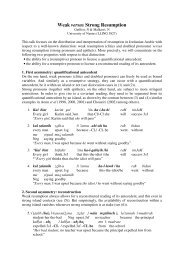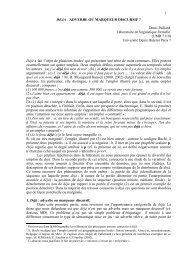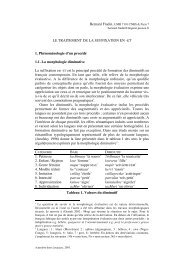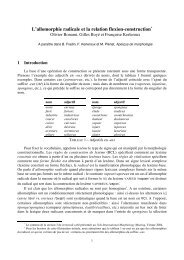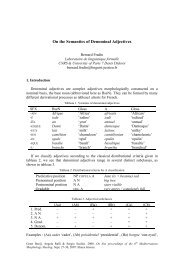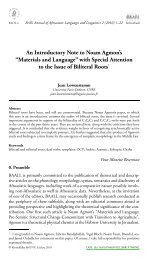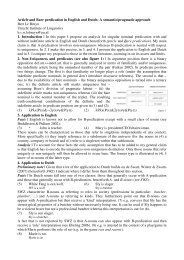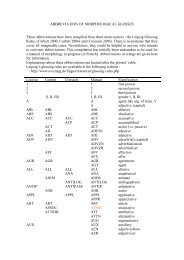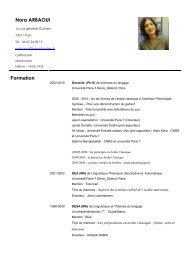HandoutPDF - Laboratoire de Linguistique Formelle - CNRS
HandoutPDF - Laboratoire de Linguistique Formelle - CNRS
HandoutPDF - Laboratoire de Linguistique Formelle - CNRS
You also want an ePaper? Increase the reach of your titles
YUMPU automatically turns print PDFs into web optimized ePapers that Google loves.
Mini-workshop on Nominalizations<br />
Universitat Pompeu Fabra, Barcelona<br />
December 14 2009<br />
Outline<br />
On Tensed Nominalizations<br />
Jacqueline Lecarme<br />
<strong>Laboratoire</strong> <strong>de</strong> <strong>Linguistique</strong> <strong>Formelle</strong><br />
<strong>CNRS</strong>-Université Paris 7<br />
lecarme@llf.cnrs.fr<br />
http://www.llf.cnrs.fr/Gens/Lecarme/<br />
Within a constructional approach of word formation, categorization and argument structure<br />
(Marantz 1996, Borer 2003), the question arises as to how much syntactic structure<br />
(if any) nominalizations share with verbal environment. Here, I focus on the role of nominal<br />
tense and event structure in the licensing of arguments in Somali nominalizations. I<br />
provi<strong>de</strong> evi<strong>de</strong>nce for the fact that the argument structure of nominalizations comes from<br />
a structure internal to the nominal itself. A full explanation of the Somali data hopefully<br />
will not be a particular statement about Somali, but rather a <strong>de</strong>eper un<strong>de</strong>rstanding of the<br />
‘right domains’ in the structure of nominal expressions.<br />
1 Parallels between verbal / nominal domains<br />
There are many suggested and suggestive parallels between the verbal / nominal domains.<br />
Such parallels have been discussed in philosophy, cognitive semantics (Jackendoff 1983),<br />
formal semantics (Carlson 1982, Krifka 1992), syntax (Abney 1987, Pesesky and Torrego<br />
2001, Hiraiwa 2005).<br />
Semantic si<strong>de</strong>: VPs name ‘properties of eventualities’ (events and states), not single events.<br />
Events have the same logical type as individual entities, i.e. . Quantifying over<br />
the event variable (‘sentence <strong>de</strong>termination’) yields ‘<strong>de</strong>finite’ or ‘in<strong>de</strong>finite’ <strong>de</strong>scriptions of<br />
events (Higginbotham 1983, Kratzer 1988).<br />
Syntactic si<strong>de</strong>: there is a <strong>de</strong>ictic reference mechanism ‘above’ the <strong>de</strong>scription of events and<br />
objects. C, like D, turns a proposition to something that can act as a argument.<br />
Verbal domain: vP has a full argument (event) structure. Voice introduces the external<br />
argument (Kratzer 1996) and interacts with (transitive) v to <strong>de</strong>termine whether accusative<br />
case is available for a vP internal constituent.
Jacqueline Lecarme<br />
On tensed nominalizations 2<br />
Nominal domain: nP is an intransitive structure. Yet nominal predicates preserve the<br />
active / stative distinction (be a hero vs. be a person, cf. Chomsky 1970).<br />
Nominals and clauses share ‘structural meanings’ carried by functional categories or features<br />
which do not <strong>de</strong>termine a phase, such as [plural] and Tense.<br />
1.1 Verbal [plural]<br />
Number can refer to entities or events <strong>de</strong>noted by nominal or verbal elements; it <strong>de</strong>rives<br />
from the ability to perceive something as a token. In natural language, we find both<br />
nominal and verbal number (e.g. Ojeda 1998, Matthewson 2000).<br />
In most Afroasiatic languages, verbal plurality is realized by morphological processes similar<br />
to those found in nominals, e.g. reduplication (Newman 1990, Fassi Fehri 2003).<br />
• No singular available, cf. pluralia tantum: <strong>de</strong>g-<strong>de</strong>g ‘to hurry’, bad-baadi ‘to look after’,<br />
guur-guur ‘to crawl’, gil-gil ‘to shake’, etc.<br />
• Shift of meaning between singular and plural: dóon ‘to want’, doon-dóon ‘to search<br />
(for)’; már ‘to pass’, mar-már ‘to travel (about)’.<br />
• Plural nominalizations: event nouns suffixed with -id, -in-, -is, -sho exhibit ‘verbal<br />
pluralization’:<br />
(1) a. qor-íd (f) ‘witing’ → qor-qor-íd (f) ‘writings’<br />
b. dil-íd (f) ‘killing’ → dil-dil-íd (f) ‘killings’<br />
c. cel-ín (f) ‘repetition’→ cel-cel-ín (f) ‘repetitions’<br />
d. qaba-shó (f) ‘arrest’ → qab-qabasho (f)‘arrests’<br />
• Pluractionality:<br />
(2) a. Shálay baa boolíis-ku sóo qabtáy 26 ká míd ah<br />
Yesterday C/F police-<strong>de</strong>fM[nom] dir. catch.past.3s 26 from one be<br />
burcád-dii<br />
gang-<strong>de</strong>fF<br />
Yesterday, the police caught 26 gangsters’ (nondistributive)<br />
b. Shálay baa boolíis-ku sóo qab-qabtáy 26 ká míd<br />
Yesterday C/F police-<strong>de</strong>fM[nom] dir. catch-catch.past.3s 26 from one<br />
ah burcád-dii<br />
be gang-<strong>de</strong>fF<br />
Yesterday, the police caught 26 gangsters’ (distributive)
Jacqueline Lecarme<br />
On tensed nominalizations 3<br />
(2a) there is exactly one catching event → (2a) expresses a pure collective reading, where<br />
the policemen jointly caught 26 gangsters.<br />
(2b) there is more than one (non-i<strong>de</strong>ntical, spatiotemporally separated) catching events →<br />
(2b) expresses a kind of distribution reading, which implies that we can find subsets of<br />
policemen and subsets of gangsters.<br />
→ [plural] does not always originate within a DP: the source of distributive interpretation<br />
is the verbal [plural] feature (not the DP’s plural inflection).<br />
Semantic pluralization: [plural] ascends from the v head and functions as an operator that<br />
pluralizes the vP predicate (cf.. Link’s (1983) cross-categorial *plural operator).<br />
1.2 Nominal Tense (and aspect)<br />
‘Nominal tense’ is a well-attested morphological phenomenon (See Lecarme 1996, 1999,<br />
2004, 2008 and the references cited there. Other manifestations in the absence of specific<br />
nominal tense morphology: non-<strong>de</strong>monstrative uses of that in English; presence of two<br />
semantically different types of <strong>de</strong>finite articles in German, see Roehrs 2006, Schwartz 2009).<br />
I assume that DP has the structure (3), where D is formally parallel to C, n*P is parallel<br />
to Voice and introduces the external ‘possessor’ argument, n is a light noun, and nP, n*P<br />
and DP <strong>de</strong>fine 3 syntactic domains for tense interpretation.<br />
(3) DP<br />
D<br />
T n*P<br />
(Poss)<br />
APPL-n nP<br />
n Root<br />
Assuming that syntax and semantics run in parallel from bottom to top, 3 (sets of) times<br />
are potentially involved in the temporal interpretation of noun phrases:<br />
(4) the predication time (i.e. the times at which a property like ‘presi<strong>de</strong>nt’ is asserted<br />
to hold of an individual),<br />
Madaxweyní-hii hore (waa imáanayaa)<br />
presi<strong>de</strong>nt-<strong>de</strong>tM.past before F is-coming
Jacqueline Lecarme<br />
On tensed nominalizations 4<br />
The former presi<strong>de</strong>nt (is coming)<br />
(5) the time of the genitive/possessive relation,<br />
(Waxaan ku bárayaa) afá-daydii<br />
hore<br />
Expl.F.1S 2S introduce wife-<strong>de</strong>tF.1S.<strong>de</strong>tF.past before<br />
(I am introducing you) my ex-wife<br />
(6) the time of (existence of) the individual (or event).<br />
a. Madaxweyní-hii wúu dhintay<br />
presi<strong>de</strong>nt-<strong>de</strong>fM.past F3MS die.past<br />
The presi<strong>de</strong>nt died<br />
b. Aníg-ii waan iská tagay<br />
Me-<strong>de</strong>fM.past F.1S<br />
As for me, I left<br />
refl.from go<br />
c. Yáa mas’úul ká ah burburín-tii Soomaaliya?<br />
who responsible from is <strong>de</strong>struction-<strong>de</strong>fF.past Somalia<br />
Who is responsible for the <strong>de</strong>struction of Somalia?<br />
Like English before, horé ‘before’ express temporal prece<strong>de</strong>nce IFF it is bound by a PAST<br />
tense (spatial otherwise).<br />
• In (4) horé applies to the predicate → the predicate is true of invividuals that once<br />
had the property ‘presi<strong>de</strong>nt’,<br />
• In (5) horé applies to the possession relation: the nominal can be used to refer to<br />
someone who was formerly ‘my wife’ and is ‘my wife’ no longer (= perfective or ‘outer<br />
aspect’) =‘the one who was my wife’ (and still is).<br />
→ cf. Chomsky (1970): there is an argument for taking the form John’s wife to<br />
un<strong>de</strong>rlie John has a wife, rather than conversely. ‘Functional category verbs’ inserted<br />
into v no<strong>de</strong>s (have, be, do, perhaps light verbs) are precisely what is lacking in<br />
nominals.<br />
• The strong pronouns have the same distribution of ordinary DPs. As pronouns<br />
contain no ‘<strong>de</strong>scriptive’ material, (6b) illustrates a clear case of temporal location of<br />
an individual.<br />
(6c) is a ‘tensed nominalization’: the nominal itself refers to a past event of <strong>de</strong>struction.
Jacqueline Lecarme<br />
On tensed nominalizations 5<br />
1.3 Event structure<br />
(Davidsonian) events are particular things, and they are <strong>de</strong>notations of - among other<br />
categories - verbs. Ordinary sentences implicitly mark reference to an event. ‘Simple<br />
event’ nouns (Grimshaw 1990) such as trip or war <strong>de</strong>note sets of events as well.<br />
(7) a. Dagáal-kii Ogaa<strong>de</strong>enya<br />
war-<strong>de</strong>fM.past Oga<strong>de</strong>n<br />
The Oga<strong>de</strong>n War (book title)<br />
b. wéerar-kii 11-kii Setembar<br />
attack-<strong>de</strong>fM.past 11-<strong>de</strong>fM.past September<br />
the 11 September attack<br />
In (7a) (a book title), nominal [past] locates the event temporally, in<strong>de</strong>pen<strong>de</strong>ntly of any<br />
‘discourse’ context or situation. In (7b), the effect of a nominal [past] is to constrain the<br />
<strong>de</strong>notation of ‘September 11’ to a set of past times.<br />
→ Nominals then are much similar to clauses with regard to temporal interpretation (tense<br />
and event structure). Tense makes it possible to chain together the various elements of the<br />
interpretation of noun phrases.<br />
→ Question: what do sentences/CPs have that nominalizations/DPs do not?<br />
2 Argument structure in Nominalizations<br />
In a constructional approach such as Distributed Morphology (Marantz 1996, 1997), the<br />
syntax (thus LF) provi<strong>de</strong>s the only way the mind has to represent compositional meanings<br />
(i.e., constructed by the computational system).<br />
Every word is the result of a syntactic <strong>de</strong>rivation interpreted with the use of the Encyclopedia,<br />
where non-compositional meanings of linguistic expressions are stored. Phases<br />
<strong>de</strong>termine the cyclic domains of semantic and phonological interpretation (Chomsky 2008,<br />
Marvin 2002).<br />
→ (cf. Chomsky 1970) N, V are not syntactic categories - need not have any essential<br />
distributional property (X’ theory). N and V must be distinguished by some internal<br />
property, i.e. some feature(s): something becomes nominal when it merges with D.<br />
→ Destruction and growth (as opposed to -ing gerunds) are never verbs at any stage of the<br />
<strong>de</strong>rivation (cf. Chomsky 1970). Roots like DESTROY and GROW are category neutral.<br />
When the root is placed in a nominal environment, the result is a ‘nominalization’.
Jacqueline Lecarme<br />
On tensed nominalizations 6<br />
2.1 ‘Agentive’ nominalizations<br />
Chomsky (1970): transitive grow involves [+cause], a lexical feature.<br />
Marantz (1996, 1997): Differences between sentential / nominal environment is syntactic,<br />
not lexical. Sentential/verbal environments allow syntactically projected agents, nominal<br />
environments do not.<br />
John’s (<strong>de</strong>struction of the city) is not a projected agent. The root DESTROY implies an<br />
agent much the way it implies a time of <strong>de</strong>struction (yesterday’s <strong>de</strong>struction of the city).<br />
→ Problem: If nominalizations embed no verbal context, what is the relation between their<br />
implied (or ‘inherent’) agent and the syntactically projected agent in a verbal environment?<br />
Why <strong>de</strong>struction, but not growth, seems to retain its agent?<br />
2.2 The ‘Possessor’ argument<br />
Nominals do not assign case to their selected objects, yet functional structure is responsible<br />
for interpreting ‘external arguments’ within nominals. Gentitive constructions crosslinguistically<br />
involve a ‘strong’ <strong>de</strong>finite artice (cf. *a book of John vs. a book of John’s).<br />
In somali, the ‘possessor’ argument (a multi-role argument) is structurally <strong>de</strong>pen<strong>de</strong>nt of a<br />
(tensed) <strong>de</strong>finite article (D+T). The prenominal ‘possessor’ must be an argument, not a<br />
modifier (8b):<br />
(8) a. búug-ga Maryan / Máryan búug-geeda<br />
book-<strong>de</strong>tM Maryan / Maryan book-<strong>de</strong>tM.Poss3F<br />
Maryan’s book<br />
b. búug-ga xisáab-ta / *xisáab-ta búug-geeda<br />
book-<strong>de</strong>tM mathematics-<strong>de</strong>tF / mathematics-<strong>de</strong>tF book-<strong>de</strong>M.Poss3F<br />
the book of mathematics<br />
In<strong>de</strong>finite constructions do not license ‘possessor’ arguments. The ‘possessive’ relation<br />
must be explicitly expressed in a ‘reduced’ relative clause:<br />
(9) a. *búug Maryan → búug [Máryan léedahay]<br />
book Maryan → book Maryan is-possessing<br />
a book that Maryan is possessing<br />
b. *ínan Maryan → ínan [Máryan dhalatay]<br />
son Maryan → son Maryan bore<br />
a son that Maryan bore
Jacqueline Lecarme<br />
On tensed nominalizations 7<br />
In Lecarme (2004), I establish a parallel between possessive constructions and double object<br />
constructions (cf. Larson 1988, Pesetsky 1995, Pylkkänen 2007). An ‘extra’ layer of<br />
semantic predication is created by adding an external argument to the nP predicate (see<br />
(3)): APPL takes nP as its complement in a complex predicate construction → transitive<br />
nominalizations do have a projected external argument, but this argument is not projected<br />
by Voice.<br />
→ If ‘possessors’ in nominalizations can be interpreted as agents even in the absence of a<br />
Voice head, where does the agentive interpretation come from?<br />
2.3 Somali nominalizations<br />
As in many languages within and outsi<strong>de</strong> Afroasiatic (e.g. Bohnemeyer 2002), roots or<br />
stems create verbs as well as nouns 1 .<br />
Somali nominalizations are never ambiguous. Roots and themes (causative, middle, passive,<br />
frequentative...) all have corresponding nominal forms.<br />
(10) a. joog- (intr.) ‘stay, wait, remain’<br />
jóog (m), jóog-id (f) ‘stay, act of standing’<br />
b. joogsa- (intr.)‘come to a halt, end’<br />
joogsa-shó ‘stopping onself’<br />
c. jooji- (tr.) ‘bring to a halt, stop’<br />
joojín (f) ‘halt, pause’<br />
d. joogjoog-(intr.) ‘stay a while, hang around’<br />
joogjóogid (f) ‘(act/fact of) hanging around’<br />
2.4 Causative formation<br />
Proposed analysis: agentive nominalizations involve CAUSE, but CAUSE has no verbal<br />
status.<br />
• CAUSE is a semantic relation between 2 events (Parsons 1990). CAUSE, like Tense,<br />
is not a category-<strong>de</strong>termining morpheme, nor a phase head.<br />
1 Note on the ‘nouniness’ of the Somali lexicon: As verbs have no infinitive form, Somali dictionaries<br />
(e.g. Yaasiin C. Keenadiid’s Qaamuska Af-Soomaliga (1976)) traditionally have no entries for verbs, but<br />
use nominal forms instead. A large subset of the verbal stems can be argued to be <strong>de</strong>nominal (Hale &<br />
Keyser 1993, 1997’s ‘unergative verbs’, e.g. cayáar ‘play’, hées ‘sing’, féker ‘think’, hádal ‘talk’). Many<br />
roots, such as dagáal ‘attack’ jóog ‘stay’, jír ‘existence/exist, are ‘ambicategorial’: there is no evi<strong>de</strong>nce to<br />
<strong>de</strong>ci<strong>de</strong> whether nominal or verbal forms are basic.
Jacqueline Lecarme<br />
On tensed nominalizations 8<br />
• CAUSE heads introduce event or eventualities syntactically: a root merged with<br />
CAUSE has the semantics of an event modifier.<br />
• CAUSE <strong>de</strong>scribes a semantic operation; whether it may attach to a particular stem<br />
or root is a matter of semantic compatibility, not syntactic selection. CAUSE selects<br />
for roots, VPs or phases (xPs) (cf. Pylkkänen 2007).<br />
In Somali, causative verb stems involve merger of CAUSE to the root, not to the unaccusative<br />
verb (vP): the causative -i suffix can affect the vowel or consonant of the root<br />
before the point of the <strong>de</strong>rivation when the xP is sent to PF → it must be attached within<br />
the xP phase, i.e. before the point of the <strong>de</strong>rivation when the theme becomes a noun or a<br />
verb (see 12).<br />
(11) a. √ XANUUN ‘pain’ + i → xanuuji- (palatalization: see Bendjaballah 1998)<br />
xanúun (m) ‘pain’<br />
xanuun- (intr.) ‘be in pain’ (both stative)<br />
xanuujín (f) ‘act of inflicting a pain’<br />
xanúuji (tr.) ‘hurt’<br />
b. √ JAB ‘break’ + i → jebi-(vowel assimilation)<br />
jáb (m) ‘fragment’<br />
jab- (intr.) ‘break’<br />
jabíd (f) ‘break’(names an event of change of state)<br />
jébi (tr.) ‘break’<br />
jébis (m), jebín (f) ‘act of breaking’<br />
c. √ JOOG ‘stay’ + i → jooji- (palatalisation)<br />
jóog (m) ‘stay’<br />
jooji- (tr.) ‘bring to a stop’<br />
joojín (f) / jóojis (m) ‘act of stopping s.o/th’<br />
(12) Root-selecting CAUSE: n/vP<br />
n/vROOT CAUSE<br />
Denominal verbs (agentive activity verbs <strong>de</strong>rived from nouns) involve merger of CAUSE to<br />
a phase head (nP). The -i suffix in (13) is attached above the domain of the phonological<br />
rule → palatalization does not occur.<br />
(13) a. tifíq (f) ‘drop’ → tifqi- ‘cause to drip’ (tr.)
Jacqueline Lecarme<br />
On tensed nominalizations 9<br />
b. fáraq (m) ‘fringe’ → farqi- ‘put a fringe on’<br />
(14) nP-selecting CAUSE:<br />
2.5 CAUSE and agentivity<br />
nP CAUSE<br />
n ROOT<br />
→ What is nee<strong>de</strong>d in a transitive nominalization is a CAUSE head, not a Voice head.<br />
• Causative uses have a wi<strong>de</strong> range of meanings. ‘Special meanings’ are realized with<br />
causative morphology, even though they do not have any agentive (or obviously<br />
causative) meaning (e.g. kac- ‘rise’; kici- ‘rouse’; kicínta códka ‘the accentuation of<br />
the vowel’).<br />
• CAUSE is semantically in<strong>de</strong>pen<strong>de</strong>nt from Voice (in Finnish, Japanese, Somali...<br />
causative heads are in<strong>de</strong>pen<strong>de</strong>nt of the Voice head as well).<br />
• CAUSE is a relation between two events; a theta-role (e.g. ‘agent’) is a relation between<br />
an individual and an event (cf. Pylkkänen 2007). The semantics of DESTROY<br />
requires an external causer, but an ‘external causer’ is not a projected argument.<br />
→ Agent interpretation is <strong>de</strong>pen<strong>de</strong>nt on CAUSE, but not vice versa: agent arguments then<br />
must be merged higher than CAUSE.<br />
→ if we combine this with the assumption that the external argument is introduced by<br />
APPL (see above), we get a syntactic tree where the predicate CAUSE first merges with<br />
the root <strong>de</strong>scribing the caused event; APPL then the relates a ‘possessor’ to the event<br />
introduced by CAUSE.<br />
(15)<br />
Poss-Agent<br />
APPL<br />
n<br />
CAUSE Root
Jacqueline Lecarme<br />
On tensed nominalizations 10<br />
The structural source of the external argument is APPL, agentive interpretation (external<br />
causer) is <strong>de</strong>pen<strong>de</strong>nt on CAUSE. The causative meaning applies first, so that the external<br />
argument can then be related to the causing (rather than the caused) event.<br />
→ If agent arguments in nominalizations were introduced by Voice, they would have to<br />
occur in the ‘possessor’ argument position. In Somali (at least), this is not the case:<br />
(16) a. Diyaarín-ta cáshar-ka (ee Máryan) waa wanaagsán tahay<br />
preparation-<strong>de</strong>fF lecture-<strong>de</strong>fM (and Maryan) F/C good<br />
The preparation of the lecture (by Mary) is good<br />
f-is<br />
b. cáshar-ka diyaarín-tiisa<br />
(ee Máryan)<br />
lecture-<strong>de</strong>fM preparation-<strong>de</strong>fF.Poss3MS (and Maryan)<br />
the lecture’s preparation (by Mary)<br />
c. *Máryan diyaarín-teeda (ee) cáshar-ka<br />
Maryan preparation-<strong>de</strong>fF.poss3F (and) lecture-<strong>de</strong>fM<br />
Maryan’s preparation of the lecture<br />
d. Máryan cashar-diyaarín-teeda (waa wanaagsán tahay)<br />
Maryan lecture-preparation-<strong>de</strong>fF.Poss3F (F/C good<br />
Maryan’s (way of) preparing lectures (is good)<br />
f-is<br />
Incorporating the theme argument (cáshar) forces the agent in the ‘possessor’ position, but<br />
the structure is not ‘eventive’ in an episodic sense (no existential reading of the incorporated<br />
noun) → cashar-diyaarínta is an ‘action type’ - a kind of preparation, with possibly<br />
spatiotemporally discontinuous manifestations (e.g., <strong>de</strong>noting the set of Maryan’s lecture<br />
notes) - or may have a result interpretation.<br />
2.6 ‘Deverbal’ agentive nouns<br />
English -er nominals are not necessarily agentive (Rappaport Hovav & Levin 1992 a. o.)<br />
The ‘<strong>de</strong>verbal’ agentive nominal analysis (i.e., root and verbalizing head combine and are<br />
subsequently nominalized by n) has problems as well, since the requirement that an object<br />
be present is not met.<br />
→ Somali agentive -é formation does not involve an affix creating a verb, but involves a<br />
possibly null, uncategorized CAUSE affix. CAUSE introduces event semantics within the<br />
nP, but the event involved is only a ‘potential’ (not existentially bound) event.<br />
(17) a. ‘Lexical’ causatives - overt CAUSE suffix (-i):<br />
arrín (f) ‘problem, affair’<br />
arrimi- ‘make a <strong>de</strong>cision’ (tr.)
Jacqueline Lecarme<br />
On tensed nominalizations 11<br />
arrimi-(y)é (m) ‘director’<br />
fáal (m) ‘omen’<br />
falli- ‘take omens, tell s.o. fortune’<br />
falli-(y)é (m) ‘fortune teller’<br />
xóog (m) ‘strength’<br />
xooji- ‘strengthen’ (tr.)<br />
xooji-(y)é (m) ‘reinforcer, amplifier’<br />
búrbur (m) ‘fragment’<br />
burburi- ‘<strong>de</strong>stroy’ (tr.)<br />
burburi-(y)é (m) ‘<strong>de</strong>stroyer, bulldozer’<br />
duul- ‘fly’ (intr.)<br />
duuli- ‘cause to fly, pilot’ (tr.)<br />
duuli-(y)é (m) ‘pilot (of airplane)’<br />
xiríir (m) ‘relationship’<br />
xiriiri- ‘link together’ (tr.)<br />
xiriiri-(y)é (m) ‘conjunction (grammar)’<br />
b. ‘Lexical’ causatives - ‘inherent’ CAUSE suffix: (action verbs/nouns)<br />
fál (m) ‘action’<br />
fal- ‘do, act’<br />
falé (m) ‘one who acts, doer; subject (grammar)’<br />
fur- ‘open’ (tr.)<br />
furé (m) ‘opener, key’<br />
díl (m) ‘mur<strong>de</strong>r’<br />
dil- ‘kill’ (tr.)<br />
dil-é (m) ‘killer’<br />
bar- ‘teach’<br />
bar-é (m) ‘teacher’
Jacqueline Lecarme<br />
On tensed nominalizations 12<br />
(18)<br />
RootP n<br />
é<br />
Root CAUSE<br />
D<br />
At the point of the <strong>de</strong>rivation where n is merged, no ‘verbalizing head’ is involved in the<br />
structure. The ‘agentive’ nominal is interpreted as an ‘external causer’, but no agent is<br />
projected.<br />
→ There are <strong>de</strong>nominal verb formation (the class of <strong>de</strong>nominal verbs laugh, cough, cry<br />
(Halle & Keyser 1993) = ‘verbalizations’, but are there (true) ‘nominalizations’?<br />
Conclusions<br />
Nominals (and nominalizations) involve an articulated event structure, but the relevant<br />
structure fundamentally does not have a ‘verbalizing’ function (cf. Alexiadou 1999, contra<br />
Borer 2003).<br />
→ Event/argument structure does not always require the projection of a verbal constituent.<br />
Nominals (and nominalizations) introduce events semantics and their own event modifiers.<br />
→ Tense and event structure can be associated with nominals. There is no evi<strong>de</strong>nce for<br />
the fact that the argument structure of nominalizations comes from a structure external<br />
to the nominal itself (cf. Chomsky 1970).<br />
3 References<br />
Abney, Steven Paul. 1987, The English Noun Phrase in its Sentential Aspect. Doctoral<br />
Dissertation, MIT.<br />
Alexiadou, Artemis. 1999. On the syntax of nominalization and possession: Remarks on<br />
patterns of ergativity. Habititation, University of Postdam.<br />
Bendjaballah, Sabrina. 1998. La palatalisation en somali. <strong>Linguistique</strong> africaine, 21, 5-52.<br />
Bohnemeyer, J. 2002. The Grammar of Time Reference in Yukatek Maya. Lincom Europa,.<br />
Munich.<br />
Borer, Hagit. 2003. Exo-skeletal vs. Endo-skeletal Explanations: Syntactic Projections<br />
and the Lexicon, in M. Polinsky and J. Moore (eds.) The Nature of Explanation in Linguistic<br />
Theory. Chicago : CSLI and. University of Chicago Press.
Jacqueline Lecarme<br />
On tensed nominalizations 13<br />
Carlson, Gregory. 1982. Generic terms and generic sentences. Journal of Philosophical<br />
logic 11, 14: 145-181.<br />
Chomsky, Noam. 1970. Remarks on nominalizations. In Studies on Semantics in Generative<br />
Grammar, The Hague: Mouton 1972, 11-61.<br />
Chomsky, Noam. 2001. Derivation by phase. In Kem Hale: A life in Language, ed.<br />
Michael Kenstovicz, 1-52. Cambridge, MA: MIT Press.<br />
Chomsky, Noam. 2008. On Phases. In Foundational Issues in Linguistic Theory: Essays<br />
in honor of Jean-Roger Verganud, ed. Carlos Otero, Robert Freidin, and Maria-Luisa<br />
Zubizarreta, 133-166. Cambridge: MIT Press.<br />
Fassi Fehri, Ab<strong>de</strong>lka<strong>de</strong>r. 2003. Verbal plurality, transitivity, and causativity. In Lecarme,<br />
Jacqueline (ed.), Research in Afroasiatic Grammar II, 151-185.<br />
Grimshaw, Jane. 1990. Argument Structure. Cambridge, MA: MIT Press<br />
Hale, Kenneth and Samuel J. Keyser. 1993. Argument structure and the lexical expression<br />
of syntactic relations. In Hale, Kenneth and Samuel J. Keyser (eds.), The View from<br />
Building 20: Essays in Linguistics in Hornor of Sylvain Bromberger. 111-176, Cambidge,<br />
MA: MIT Press.<br />
Harley, Heidi and Rolf Noyer. 1998. Mixed nominalizations, object shift, and short verb<br />
movement in English. Proceedings of NELS 28, University of Massachusetts-Amherst:<br />
GLSA. ames T.<br />
Higginbotham, James. 1983. The Logic of Perceptual Reports: An Extensional Alternative<br />
to Situation Semantics. Journal of Philosophy 80: 100-127.<br />
Hiraiwa, Ken. 2005. Dimensions of symmetry in syntax: agreement and clausal architecture.<br />
Doctoral dissertstion, MIT.<br />
Jackendoff, Ray. 1983. Semantics and cognition. Cambridge, Mass.: MIT Press.<br />
Kratzer, Angelika. 1988. Stage-level and individual-level predicates. In M. Krifka (ed.)<br />
Generiticy in Natural Language. Tubingen.<br />
Kratzer, Angelika. 1996. Severing the external argument from its verb. In Johan Rooryck<br />
and Laurie Ann Zaring, eds., Phrase Structure and the Lexicon, 109-137. Kluwer, Dordrecht.<br />
Kratzer, Angelika. 2007. On the Plurality of Verbs. In J. Dölling, T. Hey<strong>de</strong>-Zybatow<br />
and M. Schäfer (eds.), Event Structures in Linguistic Form and Interpretation, Mouton <strong>de</strong><br />
Gruyter, Berlin.<br />
Krifka, Manfred. 1992. Thematic relations as links between nominal reference and temporal<br />
constitution. In: Ivan Sag and Anna Szabolsci (eds.) Lexical Matters. CSLI/ University<br />
of Chicago Press.
Jacqueline Lecarme<br />
On tensed nominalizations 14<br />
Larson, Richard. 1988. On the double object construction. Linguistic Inquiry 19, 335-391.<br />
Lecarme, Jacqueline. 1996. Tense in the nominal system: The Somali DP, in J. Lecarme,<br />
J. Lowenstamm & U. Shlonsky (eds), Research in Afroasiatic Grammar, Selected papers<br />
from the Second Conference on Afroasiatic Languages, Sophia Antipolis 1994, pp. 159-178.<br />
The Hague: Holland Aca<strong>de</strong>mic Graphics.<br />
Lecarme, Jacqueline. 1999. Nominal tense and tense theory. In Francic Corblin, Carmen<br />
Dobrovie-Sorin and Jean-Marie Marandin (eds), Empirical Issues in Formal Syntax and<br />
Semantics 2, Selected papers from CSSP 1997, The Hague: Thesus.<br />
Lecarme, Jacqueline. 2003. Nominal tense and evi<strong>de</strong>ntiality. In Jacqueline Guéron and<br />
Liliane Tasmovski (eds), Tense and Point of View. Presses <strong>de</strong> l’Université <strong>de</strong> Nanterre.<br />
Lecarme, Jacqueline. 2004. Tense in nominals. In Jacqueline Guéron and Jacqueline<br />
Lecarme (eds), The Syntax of Time, pages 441-475. Cambridge, MA: MIT Press.<br />
Lecarme, Jacqueline. 2008. Tense and Modality in Nominals. In Jacqueline Guéron and<br />
Jacqueline Lecarme (eds), Time and Modality, Studies in Natural Language and Linguistic<br />
Theory, Springer.<br />
Link, Go<strong>de</strong>hard. 1983. The logical analysis of plural and mass terms: a lattice theoretic<br />
approach. In R. Bauerle, Ch. Schwarze and A. von Stechow (eds.), Meaning, Use and<br />
Interpretation of Language. Berlin: <strong>de</strong> Gruyter.<br />
Marantz, Alec. 1984. On the nature of grammatical relations. Cambridge, Mass: MIT<br />
Press.<br />
Marantz, Alec. 1996. ‘Cat’ as a Phrasal Idiom. Ms, MIT.<br />
Marantz, Alec. 1997. No escape from syntax: don’t try the morphological analysis in the<br />
privacy of your own lexicon, In Alexis Dimitriadis et al. (eds), Proceedings of the 21th<br />
Pemn Colloquium: Penn Working Papers in Linguistics 2:4, 201-225.<br />
Marantz, Alec. 2008. Phases and words. In Sook-Hee Choe (ed) Phases in the theory of<br />
Grammar, 191-222. Seoul: Dong In.<br />
Marvin, Tatiana. 2002. Topics in the stress and syntax of words. Doctoral dissertation,<br />
MIT.<br />
Matthewson, Lisa. 2000. On Distributivity and Pluractionality. In B. Jackson and T.<br />
Matthews (eds) Proceedings of SALT 10. Ithaca/N.Y., CLC Publications.<br />
Newman, Paul. 1990. Nominal and verbal plurality in Chadic. Foris, Dordrecht.<br />
Ojeda, Almerindo. 1998. The semantics of collectives and distributives in Papago. Natural<br />
Language Semantics 6: 245-270.
Jacqueline Lecarme<br />
On tensed nominalizations 15<br />
Parsons, Terence. 1990. Events in the Semantics of English: A Study of Subatimic Semantics.<br />
Cambridge, MA: MIT Press.<br />
Pesetsky, David. 1995. Zero Syntax: Experiencers and casca<strong>de</strong>s. Cambridge, Mass.: MIT<br />
Press.<br />
Pesetsky, David and Esther Torrego. 2001. T-to-C: Causes and Consequences, in M.<br />
Kenstowicz (ed.), Ken Hale: A Life in Language. Cambridge: MIT Press.<br />
Pylkkänen, Liina. 2007. Introducing arguments. Cambridge: MIT Press. [2002 Doctoral<br />
dissertation, MIT]<br />
Prior, Arthur. 1968. Change in events and change in things. Papers on Time and Tense,<br />
Oxford: Clarendon Press.<br />
Rappaport Hovav, Malka and Beth Levin. 1992. -er nominals: Implications for a theory<br />
of argument structure. In Tim Stowell and Eric Wehrli (eds), SYntax and Semantics 26:<br />
Syntax and the Lexicon, Aca<strong>de</strong>mic Press, New York, 127-153.<br />
Roehrs, Dorian. 2009. Demonstratives and <strong>de</strong>finite articles as nominal auxiliaries. John<br />
Benjamins.<br />
Schwartz, Florian. 2009. Two types of <strong>de</strong>finites in natural language. Doctoral Dissertation,<br />
UMass Amherst.




